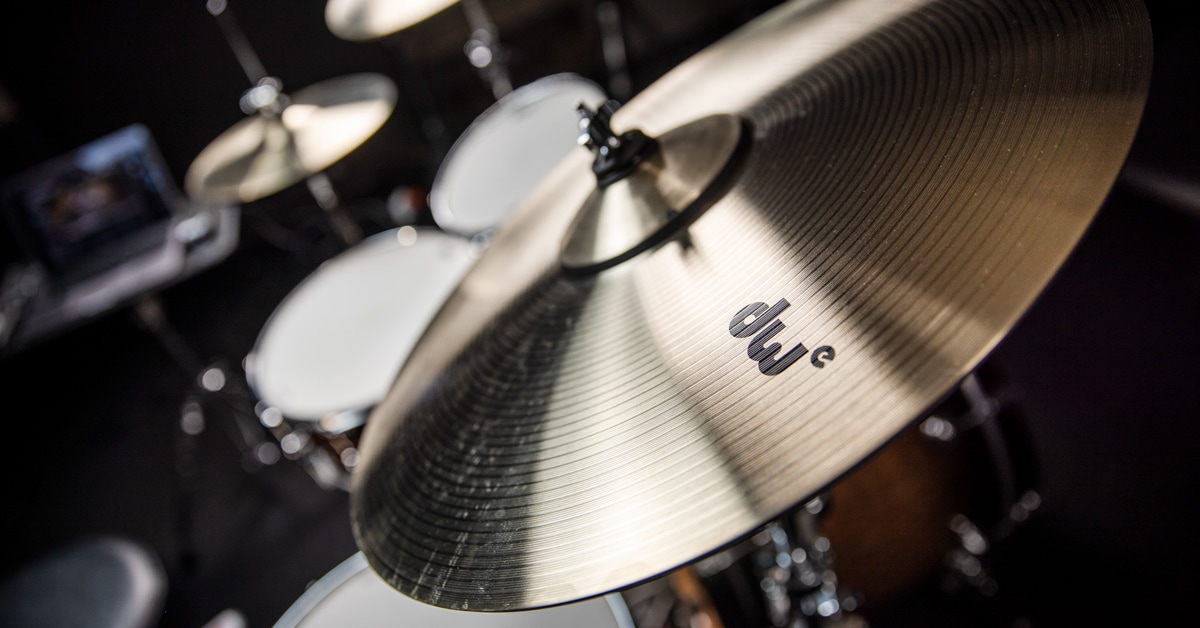Its impending birth was teased during the DW Drums 50th Anniversary celebration in 2022, and the initial scuttlebutt on DWe—labeled as the “first-ever wireless acoustic-electronic convertible drum kit”—was as propulsive as an old-school grindcore groove. Drumming virtuoso Thomas Lang called DWe a “drum set on steroids,” and DW fans drooled over the release of an electronic kit crafted with the brand’s build quality and dedication to innovation. Of course, there were others who contemplated whether DW’s wireless triggering technology would exhibit the extremely low latency necessary to translate stick impact to sound production. Groundbreaking tech doesn’t always translate into artistic productivity.
Well, a year of conjecture is now over and done. The DWe has arrived, and whether it’s for you or not, it is nonetheless an astounding achievement.
It’s certainly a “convertible,” as the made-in-the-USA DWe is built as a stunning acoustic kit that’s further enhanced by smart electronics and scrupulously recorded drum samples. You can deploy it as a full-on electronic kit, configure it as a 100-percent acoustic set or straddle both worlds by leaving some drums electronic—perhaps the snare and kick drum—and the others acoustic. In electronic mode, the ubiquitous electronic drum control module is MIA, and there are no onboard drum sounds. Instead, the DWe triggers send data to a DrumLink Wireless USB Hub and a computer loaded with DW Soundworks software.
Other DWe characteristics sure to captivate players who are less than inspired by some current e-kits include metal (not rubber) cymbals with a 360-degree playing surface, DW Collector’s Series 9-ply maple shells, traditional DW hardware (no racks) and Soundworks drum samples that feature DW, Gretsch and Slingerland kits and snares (as well as popular snares and cymbals from other brands).
To lead us through the concept and development of DWe is Brand Manager Mike Sutton, who not only details the initial impetus for DW’s exploration of electronic kits and why DW ditched cables and control modules, but he also reveals one of his favorite DWe drum sounds.
DW is obviously renowned as an exceptional maker of acoustic kits. What was the main driver that prompted the company to dive into electronics?
Mike Sutton: Well, we looked at what is currently available for drummers to play, and we asked ourselves, “What might drive someone away from electronic drum kits?” What we found is, a lot of times, it was a mixture of aesthetics, feel and set up. That discovery encouraged us to come up with the world’s first wireless, acoustic-electronic convertible kit. Now, this is not a hybrid kit. It doesn't do both at the same time—it's an either/or. You can put it in acoustic mode, where it's completely normal as a pure maple DW kit, or you can put it in electronic mode to get the experience of running through our DW Soundworks software.
The DWe is obviously not an introductory or beginner e-kit, but did you envision any particular use cases?
We looked at a couple of things. We looked at seasoned e-drummers who are looking for something they haven’t played before. That’s one of the benefits of the DWe, because it does both acoustic and electronic, so you get two kits at once. We also considered people who are new to e-drumming but are not comfortable with the current state of pad systems. These players usually don't want to get near anything that doesn't remind them of what they're traditionally used to. Then, because we have DW Soundworks, there’s another use case of people doing studio production work, and even big stage, live performance sound where different configurations of drums and cymbals are needed to match the needs of several different music styles or songs.
What was the development phase like?
DWe has been in development for six or seven years. So, we spent a lot of time and effort thinking about how we could make things better. Lots of stuff went into DWe in terms of the wireless technology, and how everything triggers when you have it in electronic mode with the mesh heads and sensors. But perhaps our main intent and goal was to ensure the instrument feels like acoustic drums when you sit down to play.
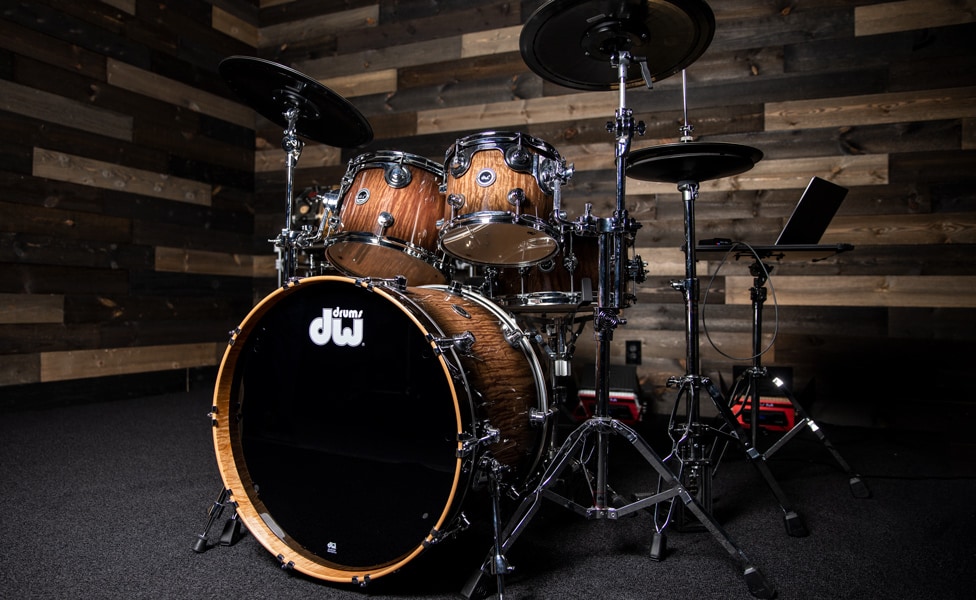
Throughout this journey, did you encounter any ergonomic or technological limitations that had to be overcome to bring DWe to market?
Constantly. There was a huge R&D curve on this one—especially when abandoning a straightforward cable system and going completely wireless from the drum and cymbal triggers to our DrumLink USB hub that feeds software.
I’m curious why didn’t you align with so-called conventional wisdom and avoid the complexity of incorporating wireless technology into all of the kit’s triggers?
We found that going to a traditional drum module is simple and easy to use, but fidelity was not always there. You know, a really good drum module is pretty expensive, as well. We found a way to get more fidelity with software—better-sounding samples and more control over the kit itself. Again, we were always coming back to figuring out how to make the DWe sound better and play better, because we knew it would be a flagship product for us.
Was it challenging to deal with crosstalk or any other anomalies when each individual pad and cymbal is sending data to a single interface?
Surprisingly not. That was the surprise. Each drum and cymbal essentially have a microcomputer inside of it and a trigger section, so the data sent to the hub is purely, “I’m a snare drum. I’m a cymbal. I’m a floor tom and so on.” We set up our parameters for a particular trigger, and once the drum gets struck, it sends micro packets of data back to the hub, so we know the velocity and all other MIDI-control data for that specific pad or cymbal.
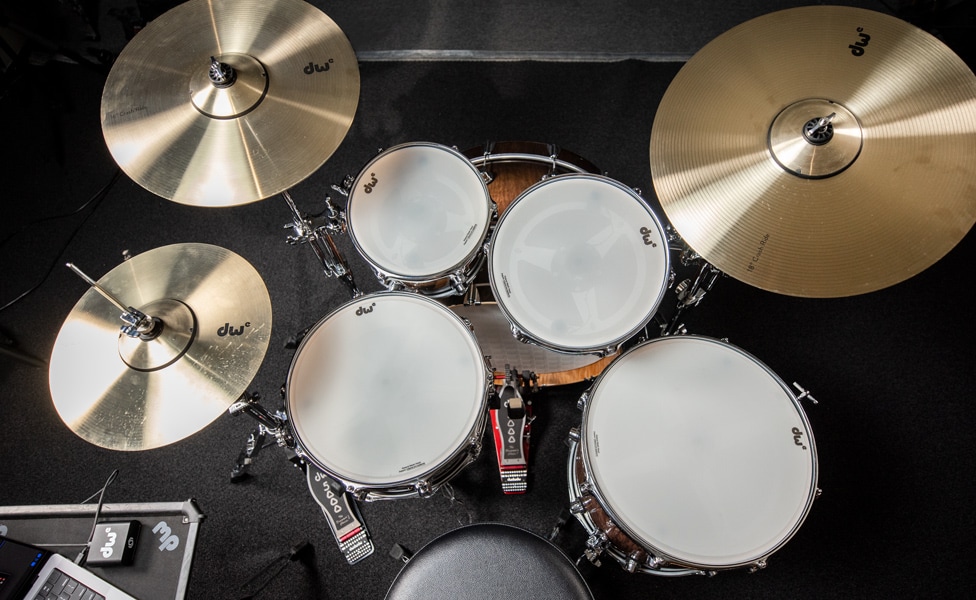
I’ve played some backlined kits at shows that used triggers to enhance the drum sound for the audience—which is fabulous, but I’d sometimes hear handclaps triggering while I was riding on a floor tom, or a snare hit in the middle of a tom-tom part. Does the DWe system pretty much negate false triggering, or is fine-tuning in software left up to the user to minimize errant sounds?
We did a pretty good job on ensuring the triggers only do what you want them to do. We even did a couple of fun tests. For example, we did a simulation of a live stage, and blasted the kit with 18" subwoofers to see what would happen. I think we only had to adjust the trigger threshold on the floor tom. That was it. Everything else did not exhibit any false triggering, and that’s exactly what you want in a live setup. You don’t want to worry about bass rumble kicking in and setting off triggers indiscriminately. This is another situation where wireless triggers help because there are no cables laying on the ground to vibrate and set something off.
Oh yeah. I forgot about those situations where a guitarist jumps onto a cable and triggers a clap track.
For sure. And let’s not forget about vibrations across a rack system that many e-kits use. You hit a rack tom and wonder why your crash cymbal is going off. Things like that can happen with rack systems. In fact, just hit the rack itself with a drum stick and you might get something to trigger from the attack and vibration. With the DWe, however, you have all of the floating mounts and hardware we use on our acoustic kits that isolate drums naturally.
It appears that wireless triggers should be a game changer for e-kits, because with conventional electronic drums, you’re simply buried in cables.
Cables are great connections, but they’re a pain, they’re not fun to set up and once you get everything cabled, you’re often stuck with that configuration. If you want to change anything, you may have to adjust your rack, move cables and do whatever you need to do. It's not intuitive, and it’s not very drummer friendly.
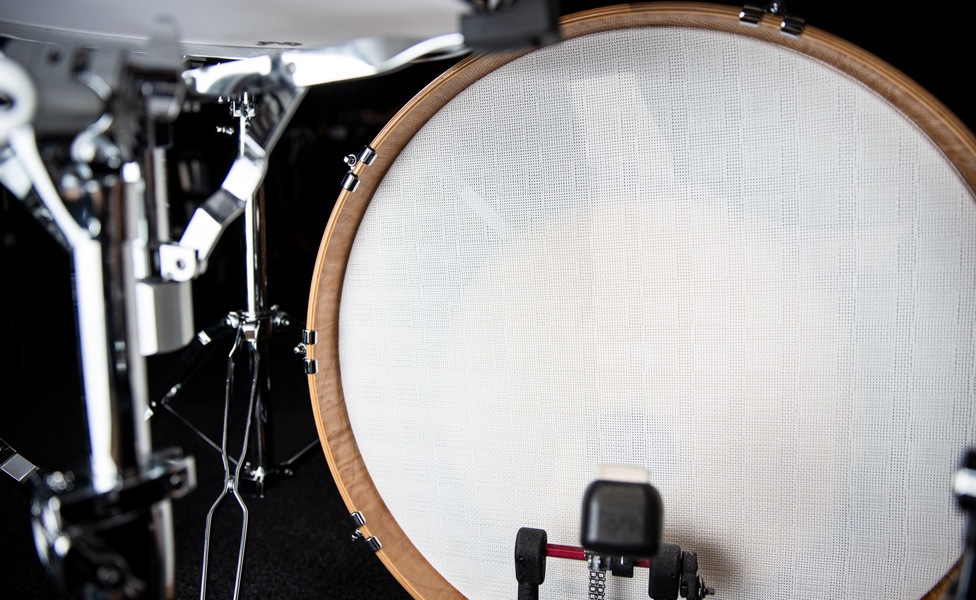
What were some of the other aesthetic and playability issues you focused on?
Some e-kits in the market look like acoustic drums, but when you play them, it feels more like you’re hitting electronic pads just by their nature. We know we can do drums because that’s what we do. For DWe, we needed to apply that know-how to electronic drums. One thing we noticed is that we had to give the drum shells bearing edges. That was a huge step right there, because any type of head sitting on top of that is going to have the increased flex you’d feel from a normal head on an acoustic kit. The next step was figuring what head combination works best. That took a while. I think it was about a year of development going back and forth on different plys and mesh combinations. We settled on 2-ply for the rack toms, 3-ply for the floor toms and snare drums, and a special woven head for the bass drum—all of which had a lot more give. Nothing felt stiff.
Then, we kept going to figure out the wireless tech. We knew we could make the triggers work wirelessly, but we had to ensure they were very quick. Imperceivable latency was the goal. Happily, we determined our latency—from the wireless system on a trigger to the wireless system on the hub—is the same as what you get when using a cable.
Let’s say I tune my traditional heads pretty low because I like my toms sounding like heavy metal cannons. If I want that type of feel on the DWe electronic heads, is there a point where detuning affects trigger effectiveness or latency?
No, but at a certain point, you're going to bottom out the head, and there won’t be any tension or rebound. You can tune the DWe trigger heads fairly low, but you have to keep in mind that you’re not using regular Mylar heads. The electronic heads are mesh. You should get to a tension you like—within reason—and we’ve found most drummers using this setup have gone for a medium or medium-high tension, depending on the drum. Myself, I like the snare drum with a bit higher tension than the factory setup, and I want more give from the floor tom.
As far as trigger response, we give you the ability in software to calibrate the drums for different head tensions. What I tell everybody is, if you detune or re-tension the kit to where you like, just go through the calibration process afterwards to make sure the triggers are optimized for your preferred tension. The process takes you about a minute.
Given the work you did devising the right feel for the mesh heads, how different are they from the rebound and attack of conventional drum heads?
The DWe heads are based on the Roland PowerPly tech, because we’re a part of Roland. In terms of feel, the 3-ply heads have a good amount of give. I like that—especially on a big 16x16" floor tom. I can lay into it and not worry about it. On the mesh snare, it feels just like you're playing on a reinforced head. We’ve done quite a bit of A and B testing—doing back and forth between traditional acoustic heads and the DWe mesh heads. We spent a ton of time on the bass drum head—which is why we're not using the regular white-mesh material. We use a completely different woven pattern and material which has more give. A lot of the mesh bass heads never feel right. They’re either very stiff or very loose. I think we dialed it in pretty good, though.
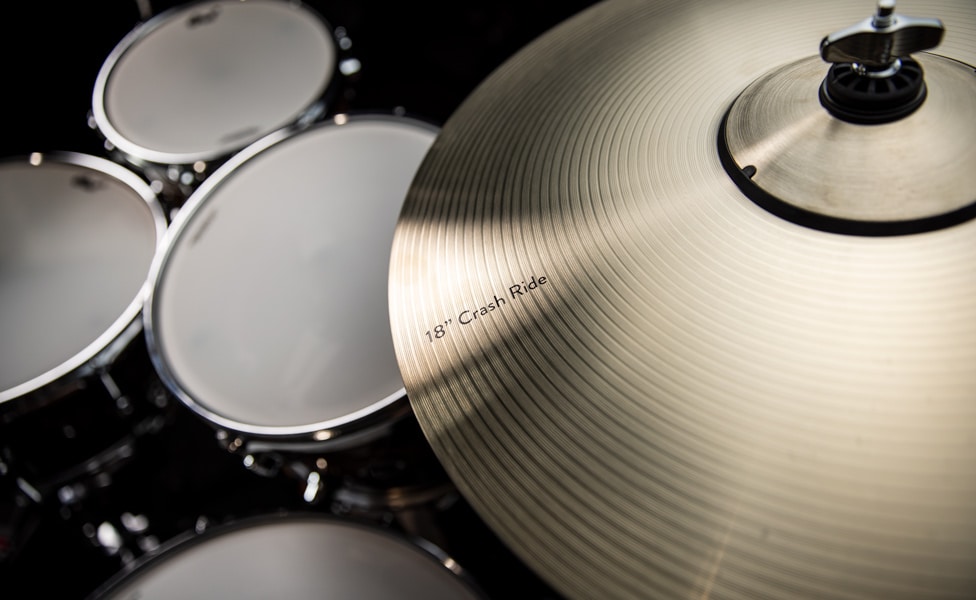
You also decided not to go with cymbals fashioned from rubber?
That was one of the things that came from tons of research, focus groups and artist feedback. So, yes, the cymbals are metal. The feel is way different than rubber, with more pronounced attack, definition and articulation.
As the cymbals are actually metal, could I leave them up if I wanted to use the DWe acoustically, or would they need to be changed out for conventional cymbals?
I'd switch them out, because they don't have any sustain. They're pretty dead on purpose to work with the triggers and all the sonic benefits of playing an electronic kit.
How many sounds can you get from each source—snare, toms and cymbals?
The snare has five zones—center, edge, cross stick, rim shot and rim click. We also devised a snare throw-off, which is like an A/B switch for snares on and snares off. So, now it’s essentially 10 zones, because you have five “snare off” and five “snare on” options. The tom zones are rim shot, rim and center.
The cymbals are all three zone but use FSR (Force Sensing Resistors) and piezos for triggering. The FSR is positioned around the entire 360-degree circumference of the cymbal, and the piezo is used for the bell and bow. This means you can play the cymbal around the whole thing—just like an acoustic cymbal.
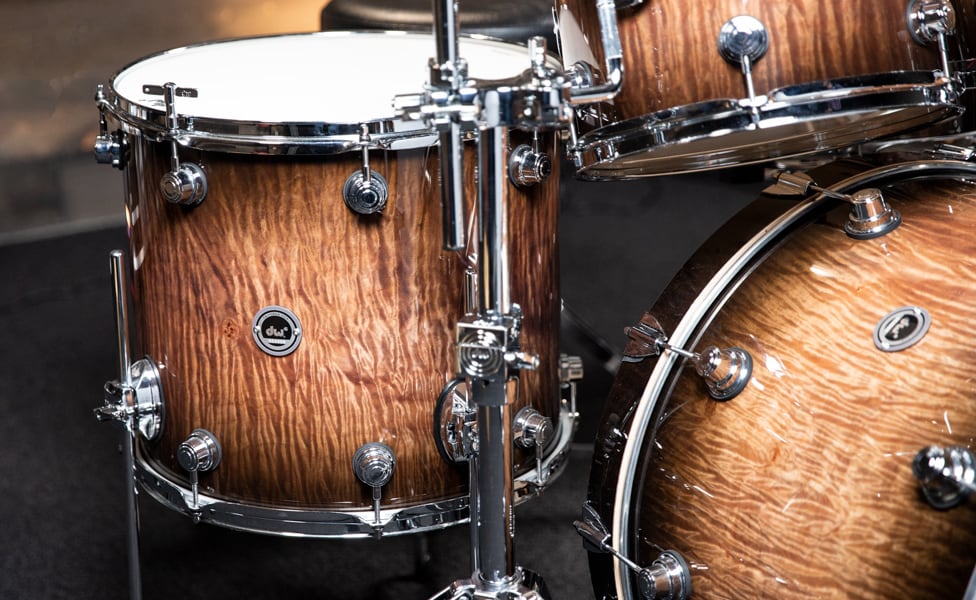
My futurist mindset had foolishly assumed you could switch from acoustic to electronic operation and back with the touch of a button. I now know that’s not how it works—yet. But how long does it take if, say, you want to reconfigure the DWe from an electronic kit to an acoustic setup?
If you want to do that, you’ll need to take off the mesh heads, remove the triggers and pop on a Mylar head. There are just a couple of key bolts on the trigger assembly plate. It’s pretty quick on the toms—maybe two minutes each tom. It’s almost as fast as taking off a drum head. The snare probably takes the most time, because you also have to remove the bottom mesh head, put on a Mylar head and install the snare wires. To completely change the DWe from an electronic to an acoustic kit would probably take 20 to 30 minutes. I recommend using a drill with a drum key drill bit, because the True Pitch 30 tension rods have more threads than your standard tension rod. We used the 30s so that drums stay in tune better. From there, it's all about how fast you can tune acoustic drums.
So, there’s no usable acoustic sound at all when using the DWe electronically—even if I were to close mic the drums?
You get a little bit of tone from the toms, because there are Mylar heads on the bottom. The kick drum also uses a Mylar resonant head. But the top mesh heads are going to let the air—and resonance—escape. Miking them up wouldn’t work because there is not enough acoustic volume. And if you tried to use Mylar heads with the existing triggers to get acoustic and electronic tones simultaneously, it wouldn’t work well, either. On the DWe, the triggers are set up so they push against the bottom of the mesh heads. Do that with a Mylar head and it kills the tone. The toms would sound like a cotton box, as this isn’t a system where a trigger sits on top of an acoustic drum head and just dampens it somewhat. But we feel the isolation and precision of the DWe system’s mesh heads and internal triggers are far more beneficial and versatile than if we had installed triggers on top of the heads.
If you do want to switch between electronic and acoustic sounds with the DWe, a cool setup is to make the toms acoustic, but leave the snare and kick drum electronic. Then, if you’re in a cover band that needs to change kick and snare sounds to match a stylistic era or a specific song, you have access to the software to dial in those tones.
For the electronic side of DWe, the DW Soundworks software provides the samples and sonic manipulations. What was the main strategy behind it, and why is it different than other drum libraries?
In the world of virtual drums, we found a lot of libraries catered toward very processed, production-style sounds, rather than natural live-sounding setups. We tried to keep processing to a minimum. But we also include presets that have a lot of processing, because that’s what some people want. That’s a different type of drum sound approach. But there are also presets that are simply mic blends with nothing else on them. We’ve given people options from really dry, organic kits to drums sounding like they came from a record. In addition, DW Soundworks contains DW kits you can no longer get, such as 50th Anniversary models and limited editions. We even sampled [DW founder] Don Lombardi’s personal 1958 Slingerland kit—which has my favorite bass drum. Super old school.
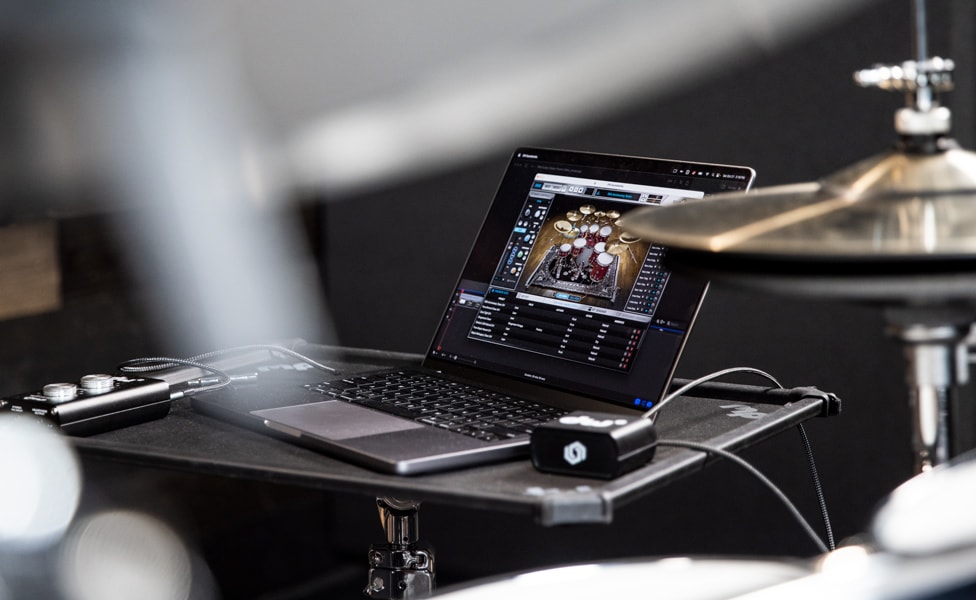
I can imagine sighs of relief from live and studio engineers if a drummer shows up with a DWe. In electronic mode, going direct can be such a “stress terminator.” Deleting live microphones from the sound equation means that, in the studio, there are no worries about microphone-phase anomalies compromising tom resonances or freaking out because the squeak of the drummer’s prized 1970 Speed King pedal is louder than the snare sound. Live-sound engineers can forget about wind gusts and crowd noise leaking into the overheads, or guitars bleeding into the snare and tom mics.
Oh man, I’ve spent way too much time doing things like throwing cotton balls into toms to stop them ringing or flipping the phase switch on mics to trace why something sounds weak. And, yes, squeaking kick pedals—“We can hear that, you know?” When things like that happen, it gets frustrating to dial in sounds, and it doesn’t feel good to play anymore. But setting up a DWe is going to be great.
Are there limitations to how I can configure my DWe?
Presently, it’s offered in a 4- or 5-piece configuration—although we are also offering some a la carte add-ons, as well as cymbal and hardware packs. The basic 4-piece shell pack comes with a 9x12" rack tom, a 12x14" floor tom, a 14x20" bass drum and a 5x14" snare. The 5-piece shell pack offers 8x10" and 9x12" rack toms, a 14x16" floor tom, a 16x22" bass drum and a 6.5x14" snare.
We had to limit the finishes to five—just to simplify things to mass produce the kits and get them out there in a reasonable amount of time. You can get Candy Black Burst over Curly Maple Exotic, Black Cherry Metallic, Midnight Blue Metallic, Black Galaxy Finish Ply or White Marine Pearl Finish Ply. They all look amazing, but it’s astounding how much the Candy Black Burst over Curly Maple pops in videos and photos.
This is such a fantastic kit. Do you think drummers will lug it to a gig at a local dive bar?
The DWe is like any other musical tool—you need to decide for yourself how best to use it, whether that’s at a casino, a big church, a club or an arena. Would I use it for a bar gig? That would depend on if the venue had a good PA system. If so, okay, great—go for it. If not, then you could still play the DWe in acoustic mode. If you’re lucky enough to have a front-of-house or monitor mixer, then the DWe in electronic mode is awesome, because it gives them all of the control, and you can just play drums.

Getting impediments to inspiration out of the way is one of the coolest things a manufacturer can do for a player. After all, for most of us, the real joy is in the playing and creating.
Absolutely. Which is why, at the end of the day, these are drums. It's not just an electronic kit. These are actual DW drums made in the Oxnard factory in California. The cymbals are made there. The trigger assemblies are made there. We make everything right there. That's a big thing, because you don't always see that. And a real human being checks everything at the end to make sure it all feels good. We do these little things to ensure we deliver an artisan-crafted instrument.










